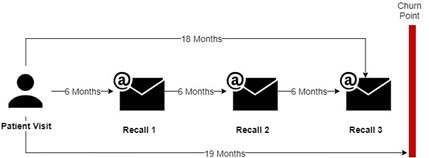Set your practice up for success with our eBook. Discover how to improve patient experience and boost revenue.
Download eBookNet Patient Gain: The three-word mantra that every practice should know when growing their patient base
When you start out as a new practice, new patients are of absolute importance. Your main focus should be on acquiring quality new patients to grow your patient base and fill up your appointment books. However, dental practices often overlook the necessary change in strategy towards patient retention once they have been operating for a few years. While it is vital to look for new patients through various advertising mediums on a regular basis, it is equally important to nurture and retain your existing patients.
Today’s dental practices spend an average of $200 per patient to acquire new patients, while it only costs them a fraction of that to retain an existing patient. An increase of 5% in patient retention can lead to a staggering 25% increase in practice profit. Most do not realise how expensive patient churn (the number of patients who stop being patients) can become for any business.
In this article, we unpack the concept of Net Patient Gain rather than focusing on new patient or patient retention strategies as they can vary from practice to practice, and there is no “one size fits all” approach. If your practice is a “leaky bucket” for dental patients, first, you need to understand how big the leak is before trying to patch it up.
For this discussion, we use the traditional three six-monthly recall cycle to illustrate patient churn. It is important to note that, nowadays, dental practices tend to tailor their recall strategies and intervals to align with their overall marketing strategy and, therefore, may not necessarily adhere to the traditional recall cycle. However, the concept of patient churn remains true.

If your patient has not returned after 18 months, the harsh reality is that you are likely to have lost that patient. Based on our recall cycle above, the 19th month since the patient’s last visit is when the practice should count them as churned patients.
We often see dental practices religiously tracking their new patients and recall effectiveness. What is surprising is that practices seldom put the two figures together to identify their net patient gain. Without understanding the correlation between these two metrics, they are just metrics on their own, not key performance indicators which are indicative of the growth and performance of the business.
Now that we know a little more about the concept of patient churn and how to calculate it, let’s put all this together to form our Net Patient Gain formula.
Net Patient Gain = New Patients – Churned Patients
If a practice acquired 25 new patients in a month but had 40 patients churning (going inactive) in the same month, their net patient gain would be:
Net Patient Gain = 25-40 = -15
Would you still call this practice a growing practice when it comes to patients? While it would cost the practice $5000 to acquire the 25 new patients at an average of $200 per patient, how much would it cost them to retain 25 of their churning patients to maintain a net patient gain of 0?
Let’s look at another example of two practices (Practice A and B)

If one simply focused on new patients, they might applaud Practice B for a large number of new patients. Yet, if you were looking at overall practice growth, which one is really growing its patient base?
For any practice, new or well-established, there is no question about the utmost importance of new patients. However, Net Patient Gain becomes an even more important statistic to help the practice avoid becoming a “leaky bucket” for dental patients.
We hope the next time you look at your new patient numbers, you also remember to check your net patient gain.
About the Author
Sean joined Centaur Software in 2021 as the Product Manager for Dental4Windows and brings with him 17 years of dental technology experience in both small business and enterprise dental arenas. He holds a Bachelor of Applied Science from RMIT University and a Master of Business Administration from Swinburne University.
Sean is a passionate data analyst who loves everything data. Outside work, Sean spends all his time doting on his little daughter Amelia.
Related Posts
-
Dental clinic marketing: Promote your practice
Published: 11/7/2024As the operator of a dental practice, you're aware of...
-
Best practices for dental practice management
Published: 4/7/2024As a dental practice owner, you want to keep your...
-
5 Tips to Grow Your Dental Practice
Published: 27/6/2024As a dentist or dental professional in Australia, you know...

